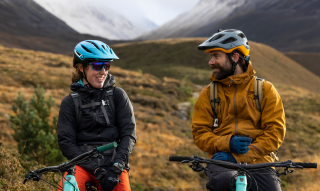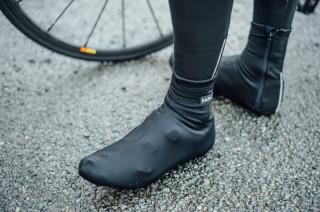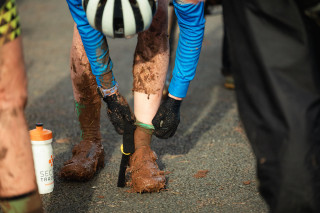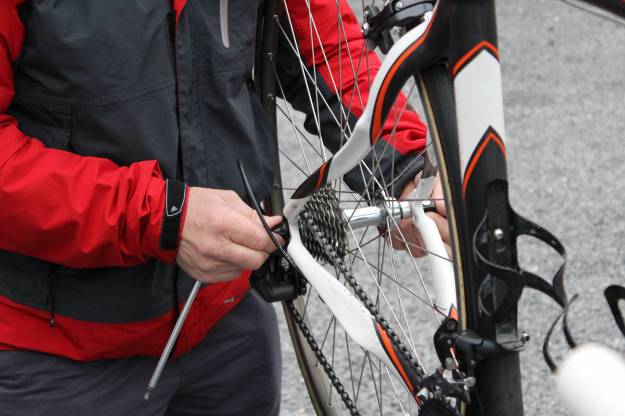Knowledge Level: Intermediate

Whether you are commuting, riding to/from school or university, heading out on the trails, or sticking to the roads, we have some advice to help keep your feet warm and comfortable during your ride.
Winter riding can be just as enjoyable as any other season with the right preparation, with a little planning you can make your ride both enjoyable and warm. A few thoughtful tweaks - whether it's adjusting your bike fit, fueling your body, or choosing the right kit - can go a long way. Embrace the crisp air and winter scenery with confidence and comfort.
General winter riding prep:
Choose your socks wisely - when it comes to cycling in the cold, sock selection can make or break your ride. Avoid reaching for the thickest, woolliest socks you can find - these can cause your shoes to feel tight, restricting circulation and making your feet colder. Instead, prioritise performance and fit.
Merino wool socks are an excellent choice. They’re lightweight, provide fantastic insulation relative to their thickness, wick moisture away from your skin, and continue to insulate even when damp. This makes them ideal for road, gravel, and mountain biking in cold conditions.
For wet rides, waterproof socks add an extra layer of protection. If your shoes allow, try layering a thin liner sock under your primary pair. This traps warm air between the layers and wicks moisture away from your skin, helping to keep your feet dry and cozy - just ensure the fit isn’t too tight.
Don’t forget your calves! Cold calves can lead to heat loss, opt for socks that extend well up your calf or even to your knees - especially for road and gravel riding where wind exposure is higher. Eliminating gaps around your ankles prevents chilly air from creeping in and rapidly cooling your feet.
For an optimal fit, and minimal faff out on a ride, test your sock and shoe combo before heading out to ensure there’s enough room for circulation. A properly fitted setup will keep your feet warm without compromising comfort.
Check for vents - do you wear cycling shoes while riding? Did you know that manufacturers design cycling shoes with multiple vents and drainage holes? If you’re using summer shoes under overshoes, have a good look over them to identify any vents and drainage holes, then cover these up with some tape. This simple step can prevent cold air from entering and warm air from escaping.
Overshoes or Booties - Both are designed to keep your feet warm, but they serve slightly different purposes. Overshoes are worn over your existing cycling shoes, acting as an additional layer to block wind, water, and cold. Booties, on the other hand, combine the functionality of shoes and overshoes into a single, winter-ready piece, offering superior insulation and weatherproofing.
Heavy-duty, insulated, and waterproof overshoes are your first line of defence against frozen feet. Look for ones that fit snugly with minimal gaps and cover most of your shoe's sole. If you are wearing shoes with cleats make sure that only the cleat and heel are exposed. Lightweight overshoes are ideal for road cyclists, while gravel and mountain bikers will benefit from thicker, more durable materials that can withstand mud and debris.
For those clocking up serious winter miles, booties can be a better investment. By eliminating the need to ‘winterize’ your summer shoes, booties offer a more integrated and hassle-free solution. They’re especially useful in extreme conditions, such as prolonged rides in freezing rain or snow.

Quick tip - a DIY hack to retain heat is to add a layer of insulation by putting tinfoil in-between the innersole and bottom of your shoes.
Fuel - part of keeping your core warm is remembering to fuel and hydrate correctly. It’s essential to think about what you’re taking with you on your ride. Will you be inside or outside when you stop? How long will you be stopping for? Do you want to bring your own snacks? Easy snacks like energy bars, bananas, or dried fruits are ideal for mid-ride fuel. Also, try using an insulated bottle with a hot drink. Check out Insight Zone for some great snack recipes
Before setting off:
So, you’ve made adjustments your bike and your kit, now you’re getting ready to get out of the door. Here are some final pre-ride rituals to ensure your feet stay warm:
Start toasty - you can start your ride with happy feet by placing your socks and shoes on the radiator to heat up before you head out. If you’re riding on consecutive days, ensure your shoes are fully dry before your next ride to prevent any moisture from cooling your feet.
Loosen your shoes - if your shoe and sock combo is too tight, it will restrict blood flow, and your feet will chill faster. To avoid this, loosen your shoes off a bit or, if you’re buying shoes or booties especially for winter riding, opt for a size or two larger.
On the ride:
Tactical stops - whether your mid-ride stop is a trail-side bench with a view or a local café, tactical stops can be really benefical. They give you the opportunity to refuel and recharge, as well as adjust your layering system if you’re getting too warm or cold. If your feet have gotten cold, it’s also a good time to take off your shoes, shake out your feet, and restore circulation.

After the ride:
Clean your kit - the part of a ride that no one particularly looks forward to, but is unavoidable and vital. Properly maintaining your kit will ensure it will continue to perform and last for the long haul. Mud, moisture, and salt / grit can quickly degrade fabric and components if not removed. Always air dry your gear before storing it and be sure to wash any waterproof items according to the manufacturer’s instructions. Keeping your kit in top condition ensures that it will keep looking after you on the next winter ride.

By preparing your bike, kit, and body for winter rides, you can stay warm, comfortable, and ready to tackle any adventure. Don’t let the cold hold you back this season!













